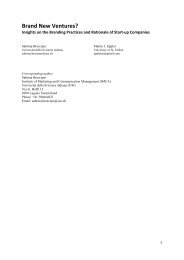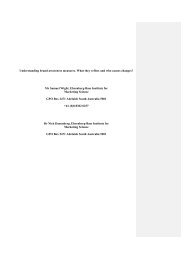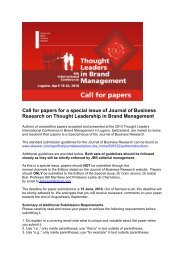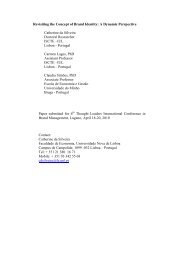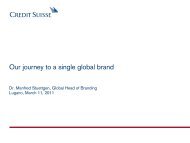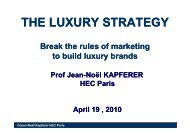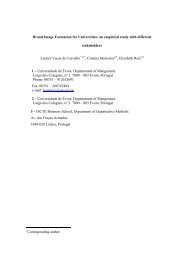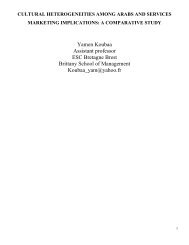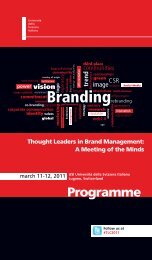Esch, Franz-Rudolf, Winter, Kai, Limited Editions
Esch, Franz-Rudolf, Winter, Kai, Limited Editions
Esch, Franz-Rudolf, Winter, Kai, Limited Editions
Create successful ePaper yourself
Turn your PDF publications into a flip-book with our unique Google optimized e-Paper software.
3LIMITED EDITIONS –EVALUATION AND RECIPROCAL EFFECTS ON FMCG BRANDSINTRODUCTION<strong>Limited</strong> <strong>Editions</strong> characterise a special form of line extensions. On the one hand, they differfrom typical extensions by their limited availability. This is indicated by labels like “limitededition” or “only for a short time”. On the other hand, limited editions are characterised byatypical variations of product attributes. An example is given by Magnum’s limited edition “5Senses”. The restricted availability of this special variation is illustrated by “<strong>Limited</strong> Edition”.Extraordinary varieties and atypical design elements support a clear distinction frompermanent offers (Fig. 1).- please place Fig. 1 about here -Whereas limited editions in high involvement categories, such as watches or art prints, lookback on a long tradition (Amaldoss and Join, 2008; Franke and Schreier, 2008), in recentyears this kind of strategy has been used increasingly in fast-moving-consumer-goods(FMCG)-categories as well. Companies use the limited-edition-strategy especially becauseof the additional growth potential and the possibility to distinguish one’s brand from theothers (Kirsche, 2005). The number of limited edition launches in the U.S. food- andbeverage-sector increased from 2001 to 2004 about 87% to 230 (Banasiak, 2005). Forconsumers, these products are very attractive because they offer something new and exciting(Banasiak, 2005; Oller, 2006; Theodore, 2004). In FMCG-categories, consumers show adistinct openness to innovations and related desires for variety and new sensory experiences.<strong>Limited</strong> editions succeed to meet these desires by their extraordinary product characteristics(Banasiak, 2005; Kirsche, 2005). The restricted availability indicates a “use-it-or-lose-it”-situation and is therefore an additional sales appeal (Oller, 2006; Theodore, 2004).RESEARCH OBJECTIVEIn spite of its high practical relevance as a special form of product line extension, there is upto now a lack of scientific discussion about the effects of limited editions on the consumer.Some authors list possible effects, like addressing the need for stimulation or positivefeedback effects to the parent brand image (e.g. Banasiak, 2005; Oller, 2006). A theoreticalfoundation respectively empirical discussion is missing. The following research issues aremain subjects of this article: What are the fundamental parameters for the evaluation oflimited editions in FMCG-categories? To what extent may the regular brand benefit frompositive feedback effects of the limited edition?THEORETICAL BACKGROUNDThe theories used, derive from the characteristics of limited editions. Effects related to thelimited availability of a product arise from theoretical approaches about scarcity. A scientificdiscussion concerning the impact of atypical products follows from categorisation theory. Inaddition, exploration theoretical approaches, which discuss the role of need for stimulation,are used.Exploration tendency: The desire for stimulation by diversification and new sensoryexperiences is assumed to be a basic motivation for buying limited editions (Banasiak, 2005;Oller, 2006). In exploration research this issue is called exploration tendency and contains



